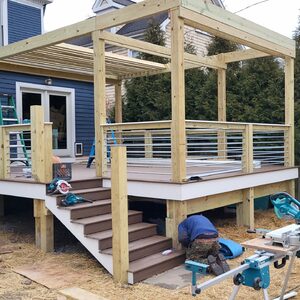Moisture inside interior electrical switch boxes. FL home – block/stucco on slab.
Moisture inside interior electrical switch boxes. I’m seeing this in two different rooms.
1) My wife noticed some drywall staining around the electrical light switch cover in the guest bedroom (on the wall next to the exterior sliding-glass door that leads to patio). I took the cover off, and the backside (inside) of the switch cover had moisture on it (like dew). I didn’t see any moisture or corrosion on the switch itself.
2) In the 1/2 bath there is a water stain that runs down from the light switch for the outside door light. This switch is on an exterior wall next to a door that leads to patio. I thought someone with wet hands used the switch and left the stain – but wife says she cleaned that stain off once, and now its back.
My house is block/stucco on slab in central FL. I am the original owner and have been in the house for 26 years.
A) Is this moisture coming from inside the wall (transmitting through the stucco, perhaps)?
B) Could this moisture be from inside the room (high humidity in room)? But if so, why is on the inside of the light switch cover.
I’m thinking maybe the exterior paint on the stucco is too old now and letting moisture through it – and I need to repaint. However there should be a vapor barrier on the inside surface of the cinder block between block and drywall (I have seen this barrier in another room that I remodeled. It looks like craft paper with aluminum foil backing on the side facing the exterior).
Any thought or suggestions on how to figure out what is going on?


















Replies
Moist air is blowing in from the outside and condensing on the AC-chilled switch plate.
Where is air leak?
That makes sense - but where is it coming from? There are no obvoius gaps in the outside walls.
Maybe a good coat of exterior paint over the old stucco will solve the problem.
The wires must get into the box somehow.
With the age home, the air is coming from ANYWHERE and EVERYWHERE. In both cases, I think you said they were switches next to doors............that would be your first clue as to where the outside air is coming from..
How cold do you keep your house that the electrical box buried INSIDE the wall is getting so cold that it has condensation on it?
At a minimum you should put those generic switch/outlet insulation covers behind the plates and maybe seal them with a little clear caulk to keep your conditioned air from pouring into the box and causing the box to cool to the point it condenses.
I keep the house at 76 degrees. Sealing the boxes is a good idea. A gasket instead of silicone is probably better so I can pull the covers from time to time to check.
If the moisture is from room humidity, then all the other boxes in the room probbaly have moisture in them to. I'm concerned that the moisture is coming from outside (like something is leaking that needs to be fixed. Is this "normal" for my house's age and climate?
Should I spray in some foam sealer around the box (maybe remove switch and drill a hole in back of plastic elec box to fill the cavity between cinder blocks and electrical box with foam).
The electrical wires come from attic and drop down into each room.
Assuming you run the AC most of the time, the condensation is from outside humidity, not room humidity. When the wind blows, air comes into the house through the outlet boxes. This is "normal" for a poorly-sealed house.
If the inside temp is 76 and the dewpoint outside is above that, you will get condensation where the air blows in. This will pretty much only happen in the South, since those conditions are not often met other places (like here in Minnesota).
The proper "fix" is to somehow seal the holes where the air leaks in. This might be, eg, behind a light fixture on the outside of the house, or it could be where a cable runs down into a wall from the attic, or up from a crawl space.
Putting on the cheapy outlet insulation will stop the problem most like but it won't SOLVE the problem as you elude. The problem is hot moist air from the outside moving within the walls....is it coming from a hole behind an exterior light as you say? Or down from the attic through a hole drilled for a wire or pipe to go up? Or is it coming from the doors not being properly sealed? Or is it coming horizontally following the wire as it moves along the wall from one of these other penetrations?
If you have a wall mounted light or electric outlet on the outside near these switches that will usually be the source of the mositure. You'll need to iunstall waterproof boxes and caulk around them. I'm in south florida and have run into the same problem several times. Wind blown rain gets in the boxes and runs down conduits or the wall.
Country,
If your duct work is in the attic it may be leaking and depressurizing the house. Smoke stick is a cheap way to check but a blower door test is better. Sometimes the POCO will subsidize these.
KK
The paint is the vapor barrier on a CBS house in Florida. The outside wall is the "warm moist side". When my wife was building houses, they would not even start the drywall until they got a coat of paint on the stucco.
Thanks for all the help. My plan it to:
1) I will start painting the outside once the love bugs are gone.
2) I will check and seal the exterior light boxes and outlets.
3) Raise the AC temp to 78 degees.
4) if the above doesn't work (or maybe I'll just do it anyways), I'll have a blower test done.
The problem is that where the air is coming from will be very hard to predict. I live i a cold climate with a basement, One winter, I had a water pipe freeze in the MIDDLE of my basement. Anyone who has a basement would tell you that this would never happen. The problem was nobody told that to the air that was finding its way across 15 feet of wall and down two stories to my pipe in the basement. You might have luck with thermal imaging figuring out where it is coming from but I'm thinking that works better when you looking for cold air leaks.
Plumbers and electricians create air paths within the walls with absolutely no care for stopping this air movement. Best of luck! I sealed all of my outlet boxes from the inside with clear caulk (although color doesn't matter). you have to turn the electric off to do it and it helps if you by some fish tank tubing as an extension to the caulk tube. You have to pull the switches and outlets out to get your finger in there to spread it and seal up all the openings and you need to get a caulk that stays flexible. You also have to seal between the box and the drywall as well.
Downside is that doing so makes it a super pain if you need to pull the wires out or put more wires in that box but the reality is most people don't do that. Then I put the foam covers on behind the faceplates and sealed those. I have an advantage in that I did mine when it was cold outside so I could literally feel the cold air moving so I knew when I had a box sealed. The plus side is its easy to do and you can get a case of caulk for less than $50 and do every box in your house in a weekend...and yes I pulled down light fixtures and sealed those boxes as well and pulled back plumbing esthucheon plates and sealed those penetrations through the drywall and don't forget your plumbing in your kitchen sink and bathroom vanity or the shower head. You even find air leakig around your shower faucet and tub spout into the wall cavity. If you really want to go at it, you can use clear caulk around the window and door trim to make up for poorly sealed/installed windows and doors. Believe or not, the baseboard trim will even leak air into the wall because in a lot of cases the drywall doesn't completely seal off the wall cavity behinf the trim.
As I said there are any number of reasons/ways for that air to be getting to your boxes.